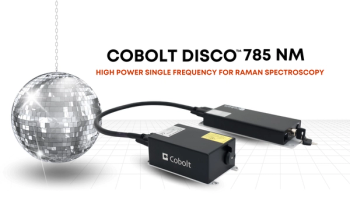
Wavelength Tech Forum: Optics/Lasers
This month's Technology Forum looks at the topic of optics and lasers and the trends and issues surrounding them. Joining us for this discussion are Rob Morris, with Ocean Optics, Sergey Mirov, with University of Alabama at Birmingham, Dan Merdes, with Penn State University, and Tim Kane, with Penn State University.
This month's Technology Forum looks at the topic of optics and lasers and the trends and issues surrounding them. Joining us for this discussion are Rob Morris, with Ocean Optics, Sergey Mirov, with University of Alabama at Birmingham, Dan Merdes, with Penn State University, and Tim Kane, with Penn State University.
How will adaptive optics change the optics industry?
(Morris) Adaptive optics really help to advance the notion of making optical components “smarter,” in the sense of removing optical distortion and the like. It’s not too difficult to imagine, say, the optical bench of a spectrometer that is fully adaptive, with adaptive optics allowing the bench to practically configure itself, or to recalibrate when temperature shifts and other conditions affect performance.
(Mirov) Adaptive optics improves the performance of optical systems by reducing the effects of optical distortion. Modern adaptive optics systems facilitate new optical observation capabilities, inspire demand for high quality telescopes, and have potential to bring major advances in astronomical imaging. In addition, adaptive optics enables new industrial, defense, and medical applications, stimulating fast growth of the optics industry. Among these applications are free space optical communication systems, ground-based and airborne direct laser weapon systems, and medical imaging.
(Kane) We were first introduced to adaptive optics (AO) by astronomers, who continue to drive many of the technological advances, although emerging DoD applications have motivated higher bandwidths, etc. Recently, though, medical research (especially ophthalmological) has employed AO, as has high power laser development, leading to advances in precision manufacturing. Keep an eye on continued improvements in all these areas! If one broadens their definition of AO, there are even more advances in the pipeline, though; mitigation of propagation through stronger turbulence (e.g., "super" resolution exploiting lensing effects), improved propagation through variable interfaces (e.g., air-sea), and even electrically-adaptive lenses.
What role can optics and lasers play in the field of nanotechnology?
(Morris) Maybe the question is better phrased the other way around: What role can nanotechnology play in optics and lasers? My point is, nanotechnology is rife with so many possibilities, the notion that it could be applied to improving or complementing optical and laser technologies is pretty sound. From the original question, the first connection that comes to mind is the use of lasers and optics in life science applications, where nanotechnologies like quantum dots are already being used as fluorescent markers and bio-tags.
(Mirov) One of the major issues of nanotechnology is to find an efficient and precise way to build and machine nano-scaled devices. Optics and ultrafast lasers can play an important role here, enabling 3-D machining of a wide variety of materials on the nanometer scale. In turn, nanotechnology enables new fields of optics, lasers, spectroscopy, sensing, medical imaging and therapy; specifically, nano-optics, low threshold quantum dots and quantum well lasers, surface and tip enhanced Raman spectroscopy, disease specific imaging contrast agent based opto-acoustic imaging, photo-thermal therapy of cancer, etc.
(Kane) Optical tweezers, continuing advances in lithography, etc. will have an impact on nanotechnology (especially in cool new areas such as single biological cell or even virus manipulation), but it might be better to think of the alternative view; how will nanotech open up new areas in optics? A great deal of the groundbreaking work coming down the road in the field of photonics will continue to be driven by nanotechnology. Everything from quantum dots to new MEMs apps to (practical) optical computingâ¦it will all owe a great deal to nano.
How are advancements in lasers affecting Raman research?
(Morris) For just about any laser-based technology, the idea of making lasers and power supplies smaller, more compact and less expensive â without sacrificing performance â is pretty compelling. Raman analysis, in particular, can be a useful tool for field analysis of chemical agents and more, so making such systems as portable as possible could have quite an impact.
(Mirov) High-resolution Raman spectroscopy requires narrow linewidth and frequency-stabilized lasers. Usually bulky and expensive Argon and Krypton lasers were used for these applications. With the advancements of external cavity diode lasers, portable diode-pumped solid-state lasers, and frequency up-converted fiber lasers, Raman spectroscopic systems have become more portable and affordable for small labs and for use in field conditions.
(Merdes) Improvements in the speed and spectral range of tunable UV lasers will make frequency-agile techniques such as coherent Raman spectroscopy and coherent antistokes Raman spectroscopy feasible for field detection of hazardous substances and other applications in environmental survey and monitoring.
(Kane) I would only add that the newest generations of compact solid-state lasers, in addition to the properties described above, are much more robust; great for the field! Keep your other eye on holographic filters and other component level advancements to have an impact as well.
What new advancements in lasers have you most intrigued?
(Mirov) Recent advances in semiconductor lasers, diode-pumped solid-state lasers, fiber lasers, fiber-bulk hybrid lasers, ultra-short, high power, and frequency tunable lasers are very impressive. The most intriguing for me are broadly tunable middle infrared lasers based on transition metal (TM) doped II-VI semiconductors. This class of lasers was introduced approximately a decade ago by Dr. Krupke group at Lawrence Livermore Lab. Active interest in TM-doped II-VI compounds is explained by the fact that these media are close mid-IR analogues of the titanium-doped sapphire (Ti-S) in terms of spectroscopic and laser characteristics. It is anticipated that TM-doped binary and ternary II-VI gain materials will lase in the mid-IR with a great variety of possible regimes of oscillation, similar to the Ti-S laser. These lasers, and especially Cr:ZnSe, really came of age.
(Merdes) The tunability of quantum cascade lasers will improve ability to detect atmospheric pollutants based on their midwave infrared signatures.
(Kane) As a field experimenter (mostly in sensing applications), I am always looking for robust instrumentation. I am therefore watching with bated breath as fiber lasers continue to advance to the point of utility; they already have the robustness and high power, but as they converge to vary small bandwidth operation, well, that’s when I will get excited! On other fronts, turn-key ultrafast lasers are opening the doors to great scientific advancements, quantum cascade lasers are growing in the agility, etc. I look forward to the days when we can all say “I don’t miss dye lasers!”
What new advancements in optics have you most intrigued?
(Morris) Certainly adaptive optics is quite interesting. Its early applications have been on the astronomical and defense side, but the opportunities seem to be much broader than that. There also seems to be a lot of promise in optical filter-based technologies for optical-sensing applications of all types, potentially with the effect of lowering costs for very application-specific needs.
(Mirov) Optics technology is progressing in many areas: from advancements in lens design that reduces the space required for camera lens assemblies, adaptive optics, more efficient LED based lighting technology, to optical tweezers, high density optical data storage, and near-field and confocal optical instruments with nanometer scale spatial resolution.
(Kane) I have two categories of answers for this question: sort of old school, pragmatic advancements, and novel, cusp of physics ones. The first includes topics such as efficient LED lighting sweeping the world, along with practical implementation of solar cells. Flexible displays, new sensing technologies, filled holey-fibers for system integration⦠all exciting! My second category, the novel stuff, includes areas such as bio-optics (growing like a weed!), entangled photons, the slowing/stopping/restarting of light, and even the pushing of our pulses down to the atto-second regime!!
I would be a bad academic if I didn’t mention the influence that optics will have on my world (as already evident at the great optics schools), and vice-versa. The study of optics/photonics is inherently multi-disciplinary. It combines E and M, quantum, materials, system engineering, etc. I believe that many traditional departments at large research universities will (and perhaps have already begun to) evolve into such multi-disciplinary departments in the future. There’s gonna be a paradigm shift. Put on your shades.
What do you think?
Newsletter
Get essential updates on the latest spectroscopy technologies, regulatory standards, and best practices—subscribe today to Spectroscopy.





